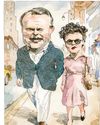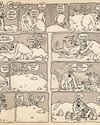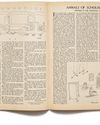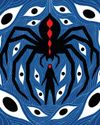
David Siegel and Scott McGehee, filmmaking partners for three decades, both read and loved the Sigrid Nunez novel "The Friend" when it was published, in 2018. They took Nunez out to coffee, then optioned the film rights to the story, wrote a script, and began making plans to produce it.
The novel, which won the National Book Award, is narrated by an unnamed writer in Manhattan whose friend and mentor, a more famous writer, has recently died by suicide. She inherits his dog, a Great Dane named Apollo. "The Friend" is about a lot of things-grief, memory, loneliness, goatish men, writing, teaching, kids today but it is, fundamentally, a love story between two bereaved creatures, writer and dog, seeking consolation and companionship in a treacherous world.
Siegel and McGehee had actors in mind for the narrator and the mentor, to whom they gave the names Iris and Walter, respectively. Now they needed their Apollo. In the fall of 2019, they reached out to the prominent trainer Bill Berloni, who has been supplying, hiring, and coaching animals for stage and screen for nearly fifty years. Berloni asked if it had to be a Great Dane. "Great Danes are big, dumb, and lazy," he told them. (Or, as he prefers to put it now, "They are sensitive, and not known for their obedience training.") "Can I talk you into another breed?"
The filmmakers insisted. The unwieldy size, the inconvenience, the majesty, the mournful bearing: these elements were essential. Plus, the cover of the novel had an illustration of a Great Dane on it-a Harlequin Dane, white with black spots, in a red collar. Film is a visual medium, and its practitioners are visual people. That image, as much as any description on the page, had captured their cinematographic imaginations.
この記事は The New Yorker の May 13, 2024 版に掲載されています。
7 日間の Magzter GOLD 無料トライアルを開始して、何千もの厳選されたプレミアム ストーリー、9,000 以上の雑誌や新聞にアクセスしてください。
すでに購読者です ? サインイン
この記事は The New Yorker の May 13, 2024 版に掲載されています。
7 日間の Magzter GOLD 無料トライアルを開始して、何千もの厳選されたプレミアム ストーリー、9,000 以上の雑誌や新聞にアクセスしてください。
すでに購読者です? サインイン

SUBJECT AND OBJECT
What happened when Lillian Ross profiled Ernest Hemingway.

ROYAL FLUSH
The fall of red.

Roz Chast on George Booth's Cartoons
There's almost nothing I like more than a laughing fit. It is a non-brain response, like an orgasm or a sneeze.

CHUKA
I have always longed to be known, truly known, by another human being. Sometimes we live for years with yearnings that we cannot name.

Rachel Aviv on Janet Malcolm's "Trouble in the Archives"
As Janet Malcolm worked on \"Trouble in the Archives,\" a two-part piece about prominent psychoanalysts who disagreed about Freud, she began a correspondence with Kurt Eissler, the head of the Sigmund Freud Archives.

PERSONAL HISTORY - A VISIT TO MADAM BEDI
I was estranged from my own mother, so a friend tried to lend me his.

AMERICAN CHRONICLES - WAR OF WORDS
Editors, writers, and the making of a magazine.

LIVE FROM NEW YORK
A new docuseries commemorates fifty years of \"Saturday Night Live.\"

TANGLED WEB
An arachnophobe pays homage to the spider.

TROUBLE IN PARADISE
Mike White's mischievous morality plays.